|
Reports of order cancellations are beginning to pop up, posing what may prove to be an advance signal of trouble for the U.S. manufacturing sector. The manufacturing sector has successfully skirted recession all year highlighted by Wednesday's durable goods report that, for a second month in a row, showed wide strength. But durable goods data are highly volatile and there's no guarantee that strength will extend to a third month. Year-on-year rates show how thin conditions have been in manufacturing: new orders down 4.4 percent and shipments down 0.4 percent. When adjusted for inflation, which has been unusually hot this year, durable goods manufacturing has arguably been in contraction.
Comments on cancellations in company statements have so far been very limited. But they have definitely been on the increase. Some manufacturers are reporting that quote activity is down and that some customers are pushing back what had been ongoing discussions for new orders. Though outright cancellations of firm orders are very isolated, the ISM's manufacturing report for July did note that a single respondent, in a rare comment, reported two cancellations in the machinery sector. The graph below compares dollar totals of manufacturers' unfilled orders (red) and new orders (blue) as reported by the Commerce Department. Backlog orders are more than three times larger in quantity, making for smooth month-to-month movements compared to the jagged movements for new orders.
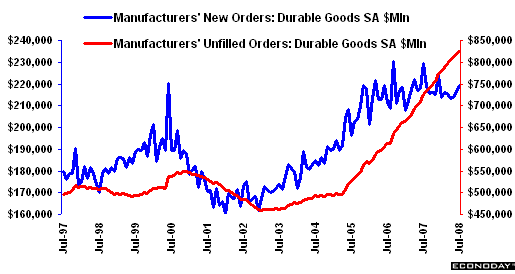
Note how backlogs lag new orders. Backlogs peaked in late 2000 after new orders had already been dropping for nearly a year. Backlogs later bottomed in early 2003, a time when new orders were well into an upswing. For the last year or so new orders have been flat at best, in sharp contrast to backlogs which, at least for now, are still on the rise.
The graph below compares new orders (blue) with shipments (brown). Shipment levels over the last several years have generally held just below new orders as they did in the latest data for July, a trend that has helped to build up backlogs in what has been a big positive for manufacturing. But shipments haven't always come in below new orders, especially evident during the 2001 recession and buildup to the recession. Though this trend is narrowing as evidenced by year-on-year rates, shipments for now at least are not ahead of orders.
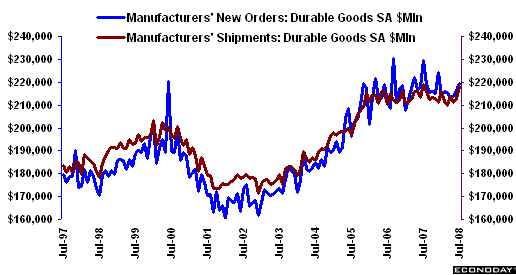
Employment not surprisingly moves with orders. The graph below compares the year-on-year percentage change for manufacturing employment (light blue) with year-on-year change in new orders (dark blue). Both new orders and employment have been in low single digit percentage decline for much of this year. Employment, like backlogs, lags new orders, reflecting the costs in money and time of adding staff when orders are increasing and the costs and disappointment of cutting staff when orders fall.
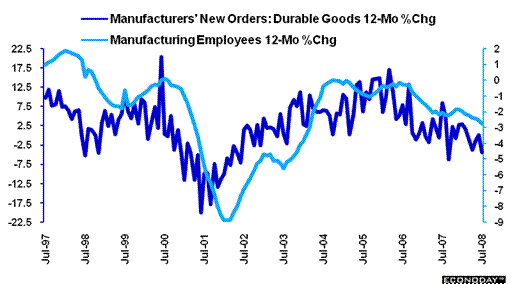
If strong backlogs are helping to limit losses in factory employment, such an effect is limited at best as seen in the graph below. Year-on-year gains in backlogs are at about 14 percent, down from a 20 percent peak two years ago but still very strong. U.S. manufacturers of course continue to move jobs offshore, a trend that blurs the relationship between orders and jobs. But backlogs, unless cancelled, will eventually have to be produced and shipped and much of it from domestic factories. Manufacturers routinely complain about the difficulty of finding and training employees — a fact, given the extent of backlogs, that may help limit future losses in factory employment.
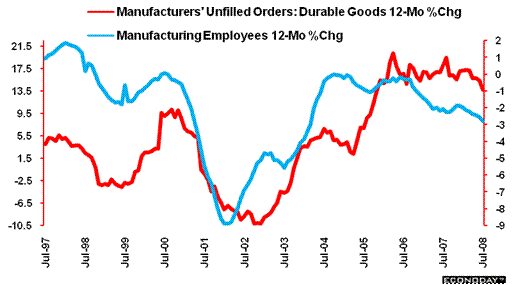
Commerce data for unfilled orders are limited to 15 years, shifting attention to the Philadelphia Federal Reserve's monthly manufacturing report on the Mid-Atlantic region that goes back 40 years. This report is especially interesting because — uniquely — it tracks the six-month outlook of its respondents. And the six-month outlook adds an important twist to the story.
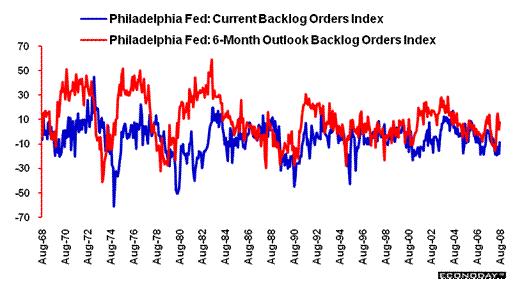
Current backlogs in the above graph (blue) are at the lower end of trend for this cycle. At the same time, expectations of future backlogs (red) have been rising. Wide separation between these measures appears when conditions are at their worst — prior to the expansion in 2001, prior to the expansion in 1992, prior to the expansion in the early 80s and prior to recoveries through the 70s. Expectations that future backlogs will rise are tied in part to a base effect that is a favorable comparison with depleted levels of current backlogs, and may in part be tied to actual and expected cut backs in production capacity. But expectations of backlog gains may also be tied to expectations that the business cycle will turn higher — expectations that the Philadelphia Fed's future backlog reading may right now be signaling! The graph below offers a close up view of the current business cycle, showing more clearly how rising expectations of backlogs led actual growth in backlogs through the first part of the expansion and again early last year and now over the last several months.
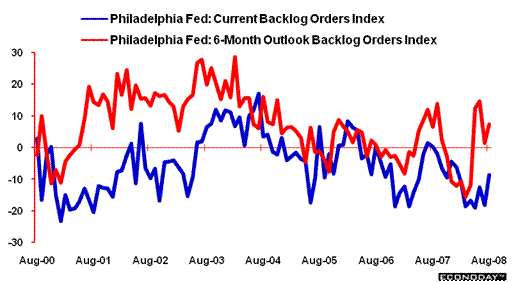
A major risk for the outlook is that aerospace backlogs are making up an unusually high proportion of total backlogs, now at 43 percent vs. 35 percent only four years ago before recovery in the airline sector began to feed a rush of Boeing and Airbus orders. But the airline sector is, as are many other sectors, now slowing, putting pressure on the finances of airlines and raising questions over their commitment to prior orders. To close, the graph below tracks year-on-year percentage changes between unfilled orders for aircraft (black) and total unfilled orders (red). --Mark Pender, Econoday senior financial writer
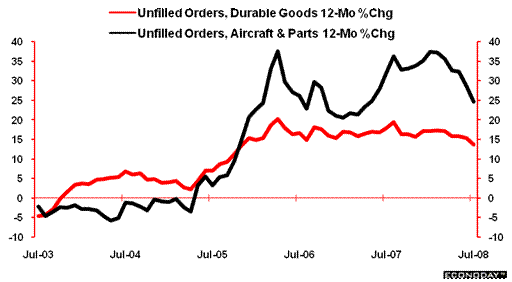
|

![[Econoday]](images/econoday_logo_slim.gif)
![[Econoday]](images/logo.gif)







